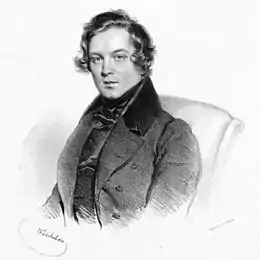Novelletten (Schumann)
The Novelletten, Op. 21, is a set of eight pieces for solo piano, written by Robert Schumann in 1838.[1] This composition is dedicated to Adolf von Henselt.

Background
The Novelletten were composed during February 1838, a period of great struggle for the composer.[2] Schumann originally intended the eight pieces to be performed together as a group, though they are often performed separately.
This set of pieces is an excellent example of Schumann's keyboard style.[1]
Analysis
No. 1 in F major
- Markiert und kräftig
- (Marked and strong)
This piece contains seven sections, alternating between a staccato march and flowing legato passages. The piece is a modified Rondo form.
No. 2 in D major
- Äußerst rasch und mit Bravour
- (Extremely fast and with bravura)
This virtuosic piece is graceful and effective. An Intermezzo section in the middle contrasts and varies the piece.
No. 3 in D major
- Leicht und mit Humor
- (Light and with humor)
This piece displays the composer's sense of humour through the use of rapid staccato chords. An Intermezzo section in the middle of the piece is used to contrast.
No. 4 in D major
- Ballmässig. Sehr munter
- (Ball-like. Very lively)
This piece is quite loosely organized in terms of structure; it is an interesting waltz that uses cross-rhythms and syncopation effectively.
No. 5 in D major
- Rauschend und festlich
- (Glittering and festive)
This piece is in the form of a polonaise; its principal section contains three main ideas which are then overcome by the persistent rhythms of the Trio section.
No. 6 in A major
- Sehr lebhaft, mit vielem Humor
- (Very lively, with much humor)
This piece uses an increasing tempo to characterize the progression of sections. Starting from the staccato opening, each of the following passages are marked a few metronome beats faster until the coda, which returns to the original tempo.
No. 7 in E major
- Äusserst rasch
- (Extremely fast)
This piece features a beautiful and lyrical middle section; it also features many virtuosic passages containing fast, brilliant octaves.
References
- Steven Coburn. Novelletten, Op. 21 at AllMusic
- "Nicholas Roth – Novelletten, Op. 21". Michigan State University Press. Archived from the original on 2007-06-22. Retrieved 2009-12-17.
Further reading
- Liner notes by Misha Donat, 2014 Hyperion Records recording by Danny Driver
External links
- 8 Noveletten: Scores at the International Music Score Library Project
- Animated score on YouTube, Piano soloist: Dino Ciani
- Performance on YouTube, Piano performed by Tim Burnelis